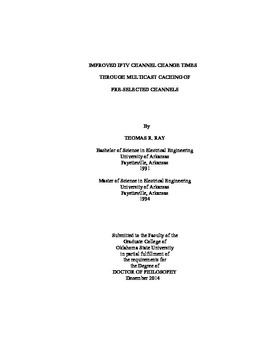| dc.contributor.advisor | Scheets, George | |
| dc.contributor.author | Ray, Thomas Randal | |
| dc.date.accessioned | 2016-01-20T15:44:53Z | |
| dc.date.available | 2016-01-20T15:44:53Z | |
| dc.date.issued | 2014-12 | |
| dc.identifier.uri | https://hdl.handle.net/11244/25708 | |
| dc.description.abstract | IPTV has grown in recent years to an estimated 100 million users worldwide. IPTV uses IGMP processes to stream an individual channel to a user until the next channel change when the current channel is stopped and the new selection begins streaming. One of the critical factors determining customer satisfaction is the requirement to have reasonably rapid channel change times of 2 seconds or less, but current channel change times are frequently above that threshold. Numerous research efforts have been ongoing to reduce these times including edge servers, I-frame management, buffering improvements, dynamic video coding, and pre-selecting channels. Channel pre-selection involves sending additional channels in hopes that the user's next selection will already be present at the user's set top box to reduce the channel change time. While this pre-selection technique has previously been proposed, the proposals have been limited in scope, typically based on set top box replacement, and lack specific details regarding the expected channel change reductions attained. This research addressed all of these shortcomings beginning with laboratory testing to verify that the channel change time reduction for successful pre-selection is two times the network delay plus the IGMP processing time which equates to an average of 320 millisecond reduction per channel change. Several pre-selection models were developed and evaluated using theoretical calculations, functional testing, and performance simulations. Sample data was generated to reflect a wide range of user IPTV viewing behavior for use in the performance simulations. The top two models resulted in an average of well over 70% success rates in accurately pre-streaming the user's next selection in the multicast cache output. This approach also has the benefit of being implemented on IPTV provider equipment and would typically only require firmware upgrades without the need for expensive new equipment or changes to existing standards. Operational considerations were also discussed to reduce problems and delays during the implementation phase of the system. Additional applications and future improvements were also presented. | |
| dc.format | application/pdf | |
| dc.language | en_US | |
| dc.rights | Copyright is held by the author who has granted the Oklahoma State University Library the non-exclusive right to share this material in its institutional repository. Contact Digital Library Services at lib-dls@okstate.edu or 405-744-9161 for the permission policy on the use, reproduction or distribution of this material. | |
| dc.title | Improved IPTV channel change times through multicast caching of pre-selected channels | |
| dc.contributor.committeeMember | Bunting, Charles F. | |
| dc.contributor.committeeMember | Latino, Carl D. | |
| dc.contributor.committeeMember | Weiser, Mark | |
| osu.filename | Ray_okstate_0664D_13775.pdf | |
| osu.accesstype | Open Access | |
| dc.type.genre | Dissertation | |
| dc.type.material | Text | |
| thesis.degree.discipline | Electrical Engineering | |
| thesis.degree.grantor | Oklahoma State University | |
